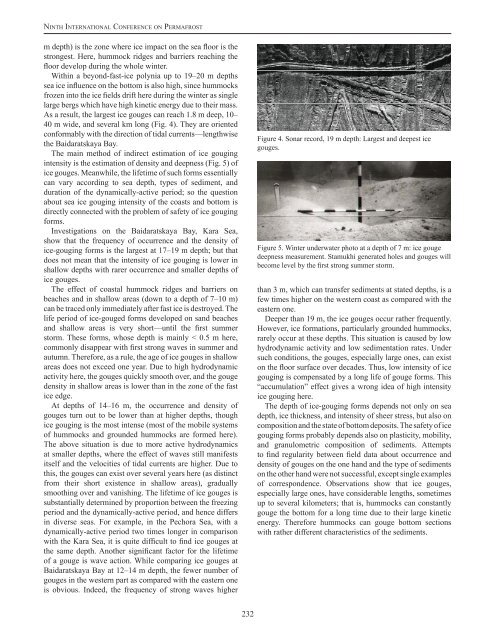Ninth International Conference on Permafrost ... - IARC Research
Ninth International Conference on Permafrost ... - IARC Research
Ninth International Conference on Permafrost ... - IARC Research
Create successful ePaper yourself
Turn your PDF publications into a flip-book with our unique Google optimized e-Paper software.
Ni n t h In t e r n at i o n a l Co n f e r e n c e o n Pe r m a f r o s tm depth) is the z<strong>on</strong>e where ice impact <strong>on</strong> the sea floor is thestr<strong>on</strong>gest. Here, hummock ridges and barriers reaching thefloor develop during the whole winter.Within a bey<strong>on</strong>d-fast-ice polynia up to 19–20 m depthssea ice influence <strong>on</strong> the bottom is also high, since hummocksfrozen into the ice fields drift here during the winter as singlelarge bergs which have high kinetic energy due to their mass.As a result, the largest ice gouges can reach 1.8 m deep, 10–40 m wide, and several km l<strong>on</strong>g (Fig. 4). They are orientedc<strong>on</strong>formably with the directi<strong>on</strong> of tidal currents—lengthwisethe Baidaratskaya Bay.The main method of indirect estimati<strong>on</strong> of ice gougingintensity is the estimati<strong>on</strong> of density and deepness (Fig. 5) ofice gouges. Meanwhile, the lifetime of such forms essentiallycan vary according to sea depth, types of sediment, anddurati<strong>on</strong> of the dynamically-active period; so the questi<strong>on</strong>about sea ice gouging intensity of the coasts and bottom isdirectly c<strong>on</strong>nected with the problem of safety of ice gougingforms.Investigati<strong>on</strong>s <strong>on</strong> the Baidaratskaya Bay, Kara Sea,show that the frequency of occurrence and the density ofice-gouging forms is the largest at 17–19 m depth; but thatdoes not mean that the intensity of ice gouging is lower inshallow depths with rarer occurrence and smaller depths ofice gouges.The effect of coastal hummock ridges and barriers <strong>on</strong>beaches and in shallow areas (down to a depth of 7–10 m)can be traced <strong>on</strong>ly immediately after fast ice is destroyed. Thelife period of ice-gouged forms developed <strong>on</strong> sand beachesand shallow areas is very short—until the first summerstorm. These forms, whose depth is mainly < 0.5 m here,comm<strong>on</strong>ly disappear with first str<strong>on</strong>g waves in summer andautumn. Therefore, as a rule, the age of ice gouges in shallowareas does not exceed <strong>on</strong>e year. Due to high hydrodynamicactivity here, the gouges quickly smooth over, and the gougedensity in shallow areas is lower than in the z<strong>on</strong>e of the fastice edge.At depths of 14–16 m, the occurrence and density ofgouges turn out to be lower than at higher depths, thoughice gouging is the most intense (most of the mobile systemsof hummocks and grounded hummocks are formed here).The above situati<strong>on</strong> is due to more active hydrodynamicsat smaller depths, where the effect of waves still manifestsitself and the velocities of tidal currents are higher. Due tothis, the gouges can exist over several years here (as distinctfrom their short existence in shallow areas), graduallysmoothing over and vanishing. The lifetime of ice gouges issubstantially determined by proporti<strong>on</strong> between the freezingperiod and the dynamically-active period, and hence differsin diverse seas. For example, in the Pechora Sea, with adynamically-active period two times l<strong>on</strong>ger in comparis<strong>on</strong>with the Kara Sea, it is quite difficult to find ice gouges atthe same depth. Another significant factor for the lifetimeof a gouge is wave acti<strong>on</strong>. While comparing ice gouges atBaidaratskaya Bay at 12–14 m depth, the fewer number ofgouges in the western part as compared with the eastern <strong>on</strong>eis obvious. Indeed, the frequency of str<strong>on</strong>g waves higherFigure 4. S<strong>on</strong>ar record, 19 m depth: Largest and deepest icegouges.Figure 5. Winter underwater photo at a depth of 7 m: ice gougedeepness measurement. Stamukhi generated holes and gouges willbecome level by the first str<strong>on</strong>g summer storm.than 3 m, which can transfer sediments at stated depths, is afew times higher <strong>on</strong> the western coast as compared with theeastern <strong>on</strong>e.Deeper than 19 m, the ice gouges occur rather frequently.However, ice formati<strong>on</strong>s, particularly grounded hummocks,rarely occur at these depths. This situati<strong>on</strong> is caused by lowhydrodynamic activity and low sedimentati<strong>on</strong> rates. Undersuch c<strong>on</strong>diti<strong>on</strong>s, the gouges, especially large <strong>on</strong>es, can exist<strong>on</strong> the floor surface over decades. Thus, low intensity of icegouging is compensated by a l<strong>on</strong>g life of gouge forms. This“accumulati<strong>on</strong>” effect gives a wr<strong>on</strong>g idea of high intensityice gouging here.The depth of ice-gouging forms depends not <strong>on</strong>ly <strong>on</strong> seadepth, ice thickness, and intensity of sheer stress, but also <strong>on</strong>compositi<strong>on</strong> and the state of bottom deposits. The safety of icegouging forms probably depends also <strong>on</strong> plasticity, mobility,and granulometric compositi<strong>on</strong> of sediments. Attemptsto find regularity between field data about occurrence anddensity of gouges <strong>on</strong> the <strong>on</strong>e hand and the type of sediments<strong>on</strong> the other hand were not successful, except single examplesof corresp<strong>on</strong>dence. Observati<strong>on</strong>s show that ice gouges,especially large <strong>on</strong>es, have c<strong>on</strong>siderable lengths, sometimesup to several kilometers; that is, hummocks can c<strong>on</strong>stantlygouge the bottom for a l<strong>on</strong>g time due to their large kineticenergy. Therefore hummocks can gouge bottom secti<strong>on</strong>swith rather different characteristics of the sediments.232
















